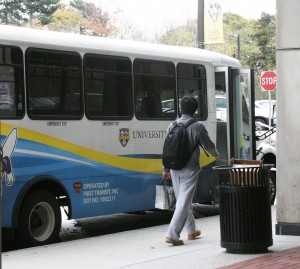
Drue Sokol, Photo Editor
As announced by the Transportation Advisory Committee (TAC) earlier this spring, the University will roll out its newest fleet of First Transit buses complete with state-of-the-art equipment during the coming weeks. The overhaul, which began this summer when UR bought 19 new buses — four small, six medium and nine large — includes a new card reader system, DriveCam and a revamped mobile app.
According to University Parking and Transportation Services Business Manager Mark Miller, the 10 small and medium buses have already arrived and begun operating. The nine remaining buses should arrive by late November to early December, with all 19 buses in operation and equipped with the new hardware by January 2013.
Among other additions, the new buses will debut a card reader system. Once the readers are installed, riders will swipe their UR IDs when boarding and exiting. By doing so, they will provide TAC with information useful for studying trends in the buses’ ridership and gauging which stops are most frequented.
“These card readers will allow us to better understand who our riders are and where they are going,” Associate Dean of Students and TAC Co-Coordinator Anne-Marie Algier said. “We will be better able to know what populations we are serving and how best to allocate [our] services.”
Algier explained that the TAC will affix signs to buses reminding riders to have their UR IDs ready to swipe as they board. She also said that drivers will not refuse riders without cards and manually log the rider instead — a caveat former SA President and Key Scholar Bradley Halpern deems “important.”
“One potential concern I had was that people without a card would not be able to ride the buses,” he said. “I’m glad that will not be the case.”
Besides the card readers, the TAC will install DriveCam, a system that combines data and video analytics with driver feedback to reduce collisions and fuel consumption. Though UR will be piloting the technology, DriveCam has monitored over three billion miles of road elsewhere and manages the world’s largest database of its kind.
“DriveCam will enable us to better monitor our drivers’ performance and document incidents,” Miller said.
Alongside the development of cutting-edge hardware, the TAC-updated, complementary software, namely TransLoc — a GPS technology that allows riders to track buses in real time via their smartphones.
Demoed by Miller at TAC’s last meeting, the next version of TransLoc will continue to be accessible from the UR Mobile app available on iOS and Android platforms. Though UR Mobile currently uses TransLoc to track certain routes, such as the Orange Line, the update will expand coverage to all buses.
Touting the app’s “convenience,” Algier is “really excited about [its] capabilities and think it will be quite helpful for riders.”
While admitting that it may be too early to tell, Halpern maintained that TransLoc is “a strong step forward and will be useful for anyone riding the UR shuttles.” He added that he would love to someday see monitors in the IT Center displaying a live feed of all the buses and their current positions.
According to Miller, the 10 new buses already operating will receive TransLoc trackers and card readers by late November, while the remaining nine buses will have the equipment installed in January. He said that the DriveCams have shipped and will be installed “as quickly as possible.”
Meanwhile, the remnants of the old fleet will receive TransLoc trackers but neither card readers nor DriveCams.
Amid some student speculation, Algier denied plans to merge the Red and Orange lines, both of which shuttle between the River Campus and downtown Rochester.
“We just made substantial changes,” she explained. “We would like to get more information on our ridership through the reader system before making further changes.”
Citing recent praise from students about “how quickly they can commute to and from Eastman for their classes and lessons,”
Algier added that “meeting those academic needs [remains] our main priority.”
Gould is a member of the class of 2014.
